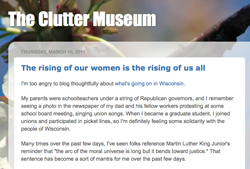One hypothetical I play with all the time is where I’d go if I had one chance to travel back through time–if I could visit any time and place in human history for, say, a week.* Typically I decide I’d visit the 1893 Columbian Exposition because I’m all about the wackiness of the 1890s U.S.
Every once in a while, however, my resolve–to taste the first Cracker Jacks, walk through Machinery Hall, and sip Pabst before it won that blue ribbon–wavers.
Tonight is one of those moments.
See, it’s pretty easy for me to develop a good deal of affection for the long-dead women scientists I study, but occasionally one proves standoffish, and I can’t seem to crack her shell. In a sense, in my searching for her, she refuses to be found.
Tonight, however, I managed to fall in love a little with Lester Rowntree (1879-1979), who studied and sustainably collected the seeds of native Californian plants.
In 1939, when she was 60, Rowntree wrote a fabulous article in The Atlantic Monthly about her travels around the state. (In her 50s she had gone through an apparently ugly divorce and found herself deliciously free of the concerns that had plagued her for decades, so she opted for largely solitary travel and exploration.)
Her article is so damn delightful, and it speaks to me not just as an historian, but as an English major because so many of her stories do important metaphorical work for this historian-come-lately. Her anecdotes remind me of the importance of taking calculated risks, which is something I sometimes forget to do when I’m comfortably ensconced in my windowless, fluorescent-lit office in the history department.
Here’s Rowntree writing about her next adventure:
I expect the going will be tougher than anything I’ve had so far, but I’ve heard so many terrible tales about the dangers to a lone woman on desolate Mexican byways that I’ve stopped believing any of them–things cannot be as bad as they say. At any rate I’m surely going to find new flowers and see new country, and as my friends often remind me, ‘Sensible people don’t have adventures.’
And then there’s this anecdote:
“Are you the woman that’s lost in the mountains?” [one of the two men picking their way through the chaparral] yelled.
“No!” I said indignantly.
“You must be,” they said.
“I’m not!” I shouted.
Ignoring this, they announced, “We’ve come to find you.”
“You can’t,” I said, “because I”m not lost.” […]
“Better come with us,” they pleaded.” […]
“I won’t,” I said firmly. “I’m not lost and I won’t be found.”
Excuse me for a moment–I’m setting the dials of my time machine to 1939; I’m going to explore Mexican byways with Lester Rowntree. I’ll let you know when I return.
*What about you? Where would you go in a time machine? And would you travel forward or backward in time? I’m curious.


I take it the 1893 wackiness is not the kind written about in “Devil and the White City”? That was a dark tale, but the whole description of how the Expo came off was really exciting to read about.
Time machines? I’d take backwards to understand. Maybe the american west before white settlers; perhaps to be in Da Vinci’s lab.
Well, the wackiness is written about in the alternate chapters of Devil in the White City–the ones about the building of the fair, not those about H. H. Holmes.
Peering into Da Vinci’s lab would be awesome.
She sounds delightful!